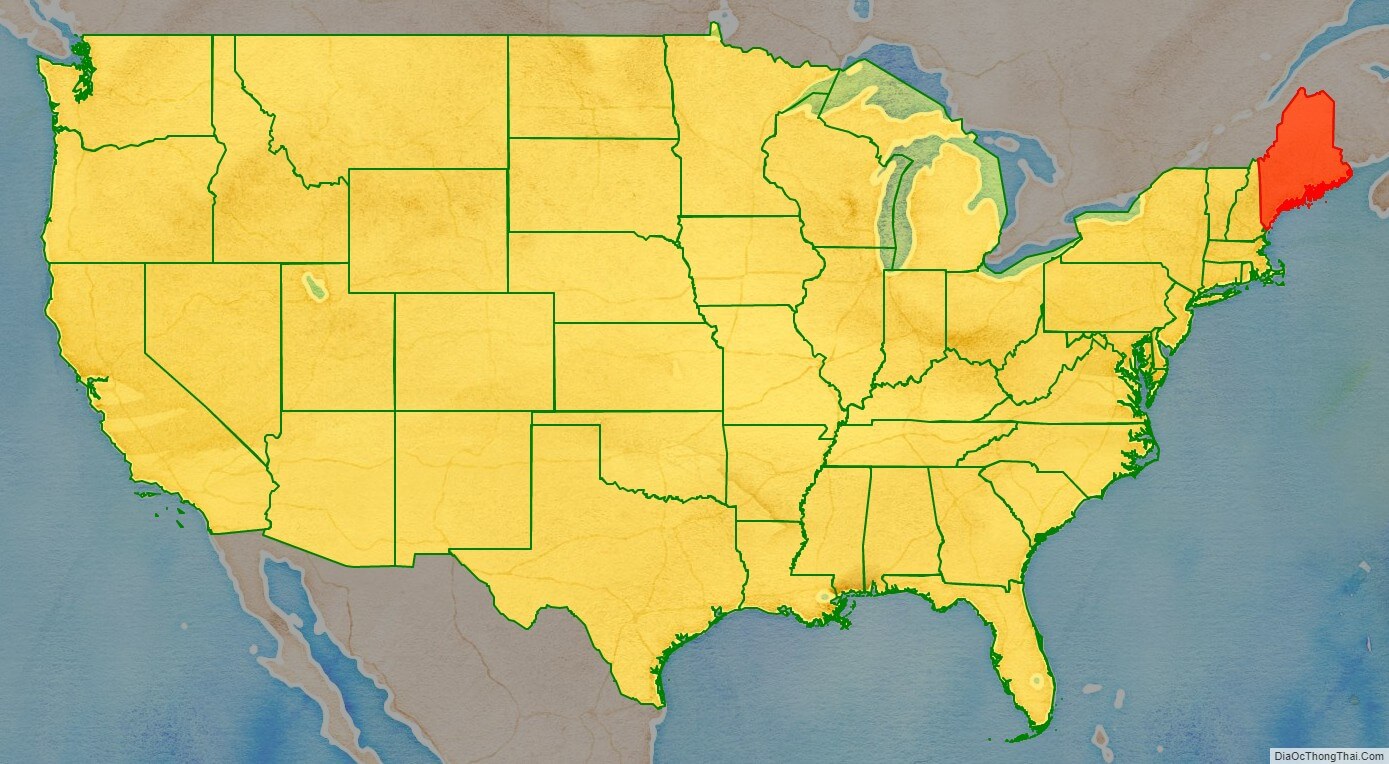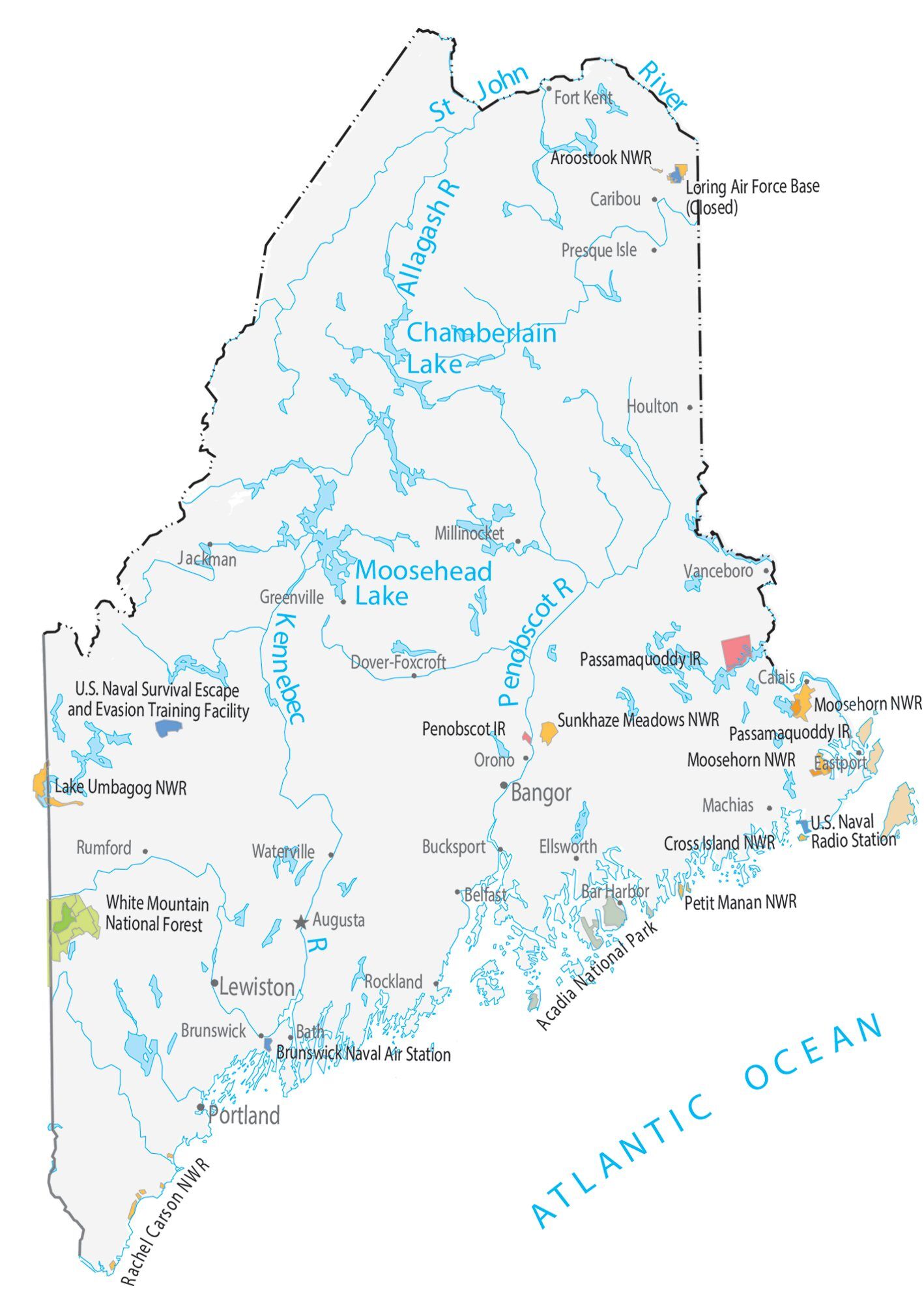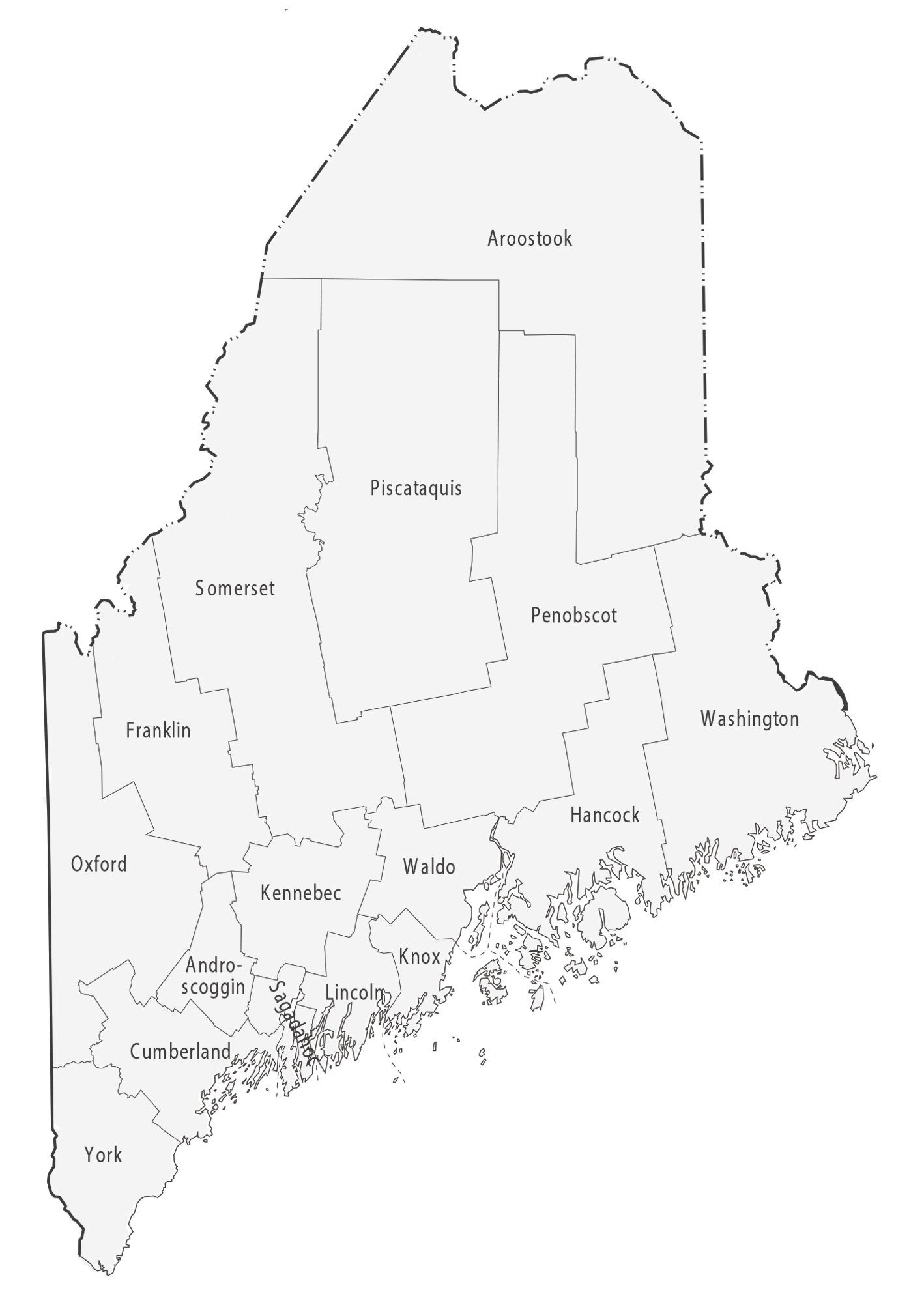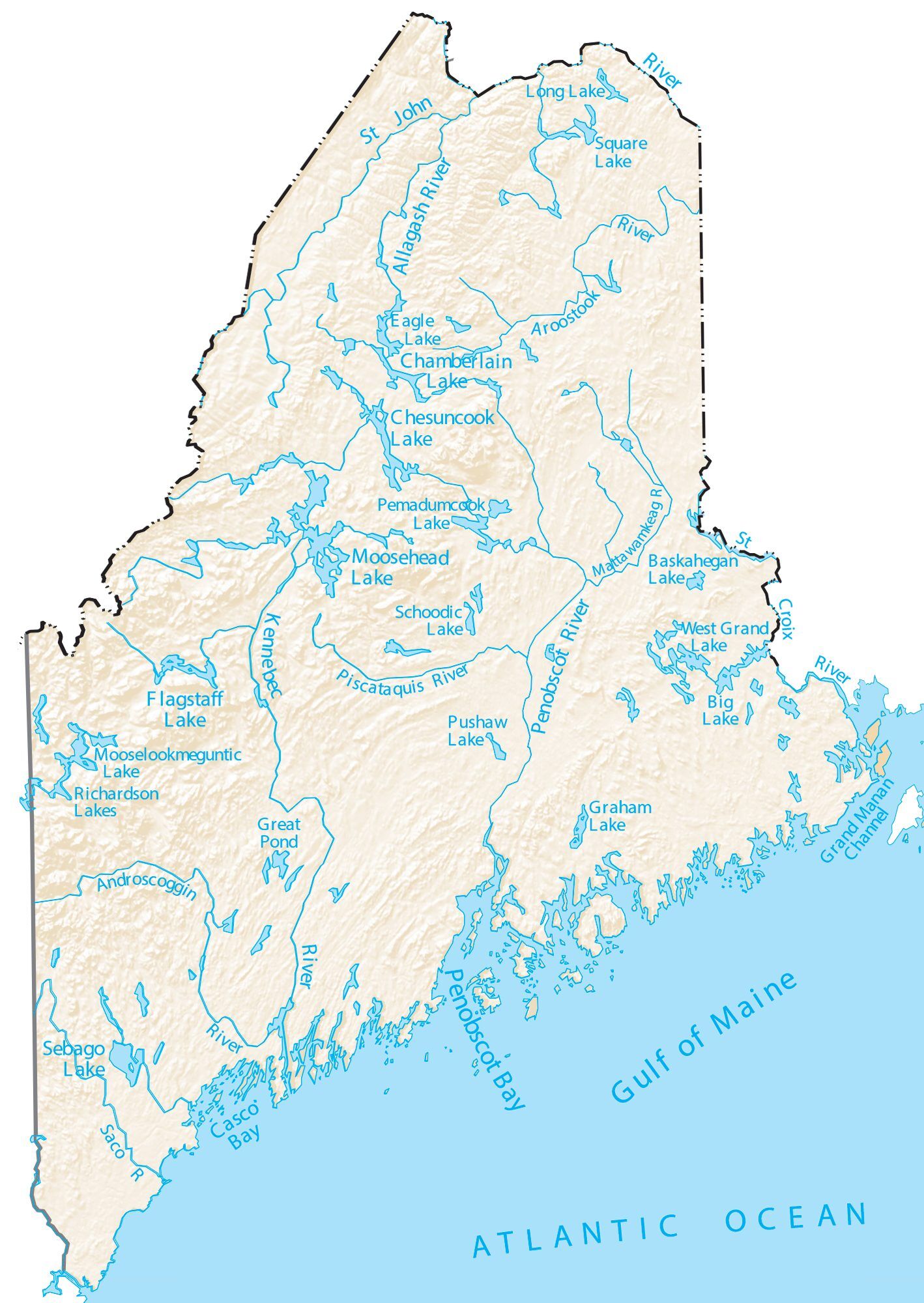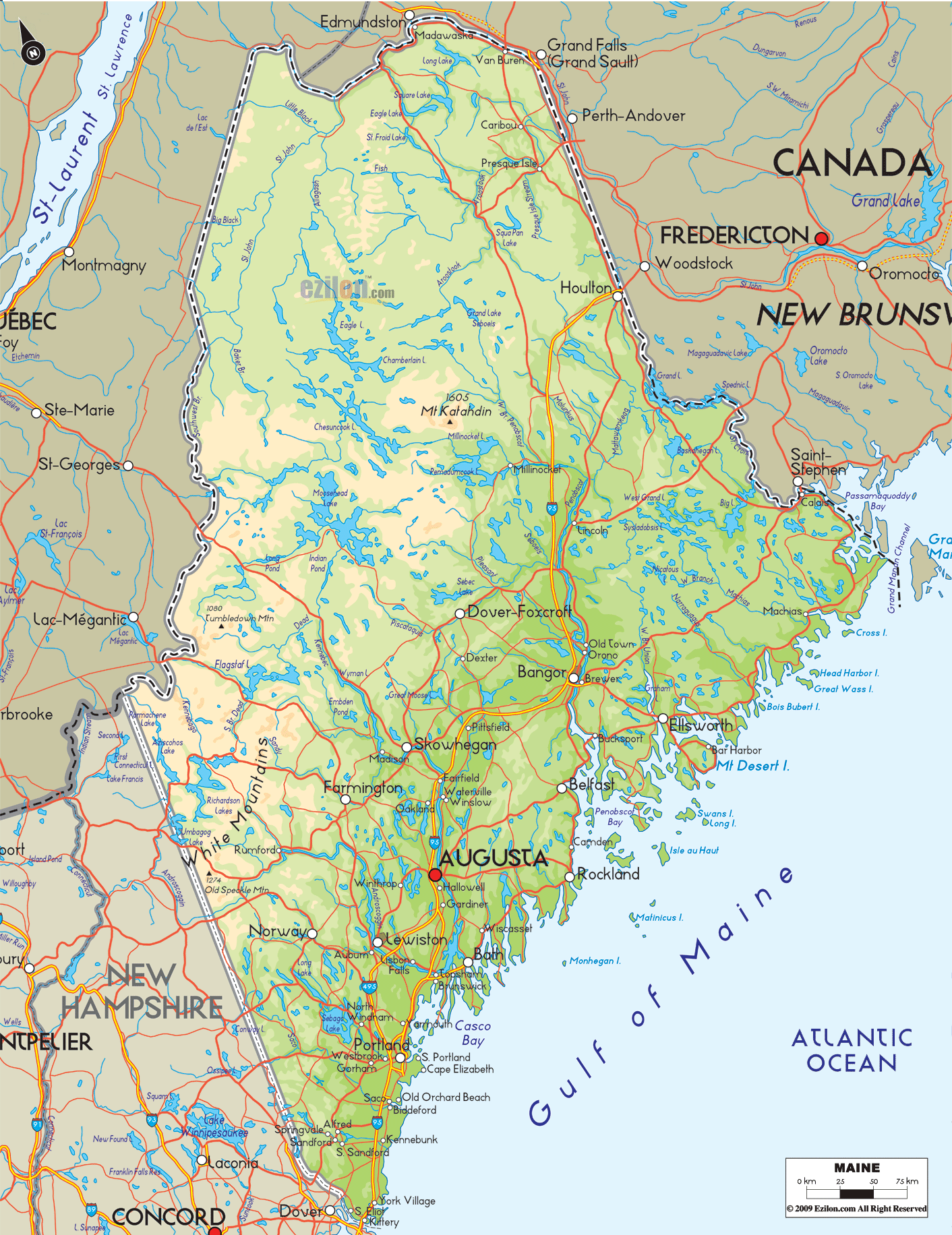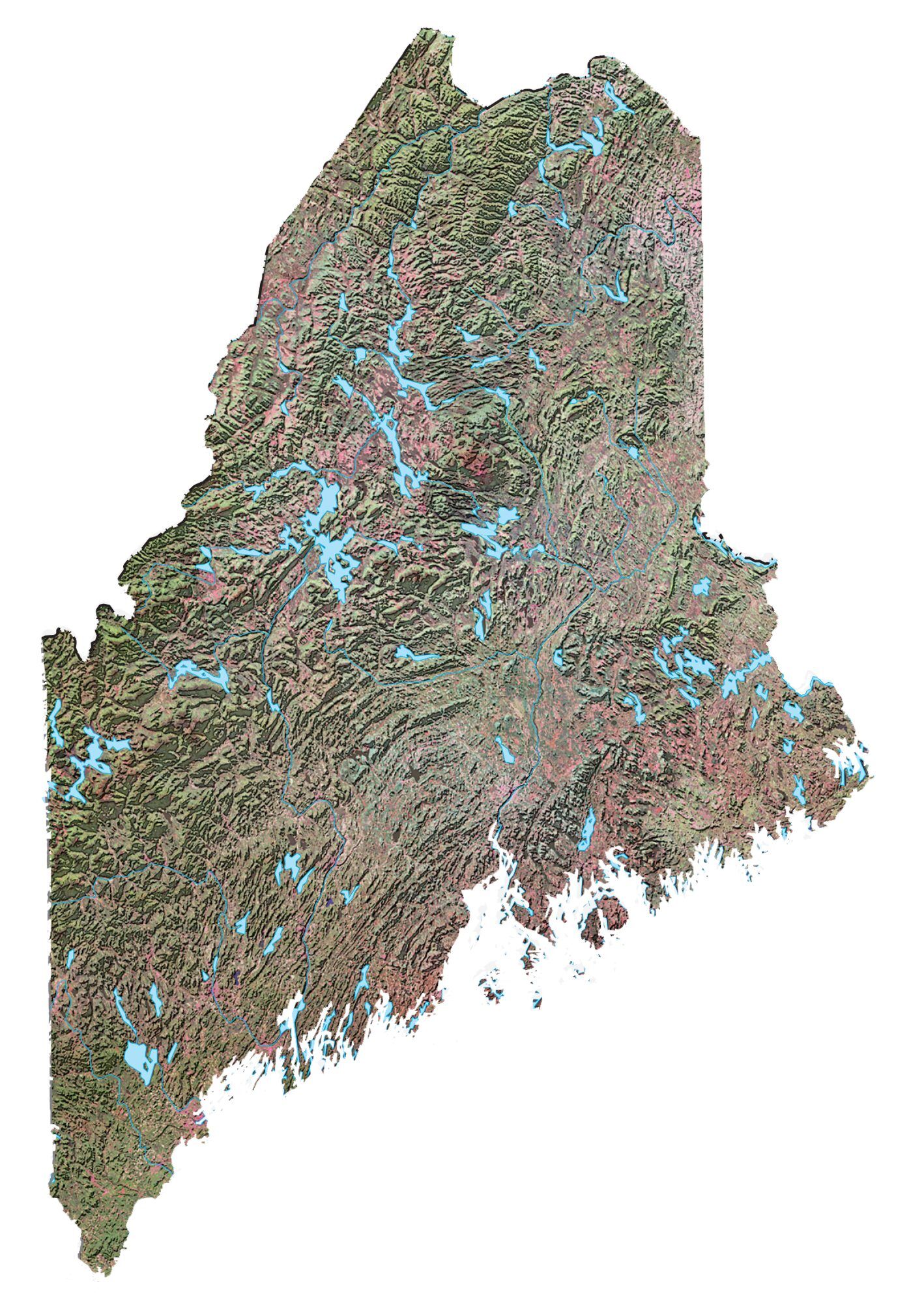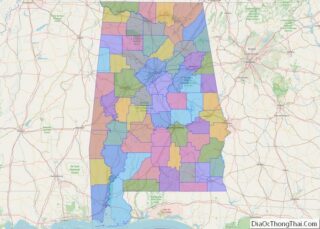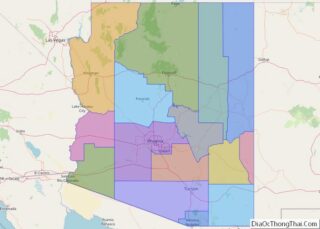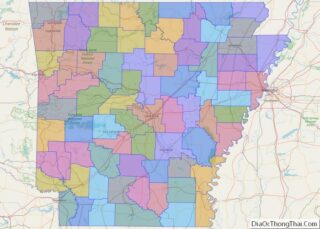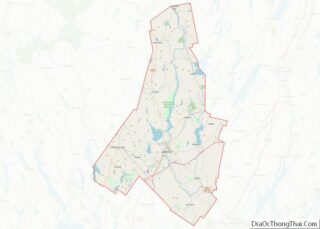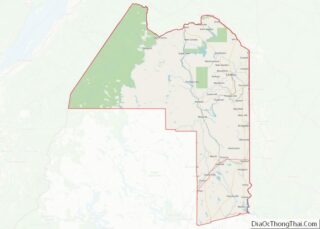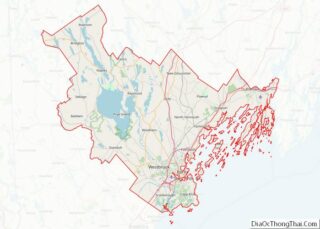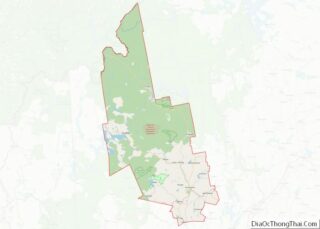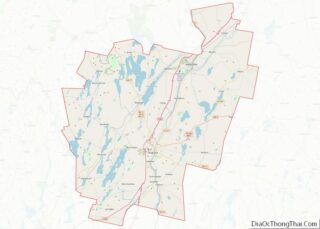Maine (/meɪn/ (listen)) is the easternmost state in the New England region of the Northeastern United States. It borders New Hampshire to the west, the Gulf of Maine to the southeast, and the Canadian provinces of New Brunswick and Quebec to the northeast and northwest, respectively. The largest state by total area in New England, Maine is the 12th-smallest by area, the 9th-least populous, the 13th-least densely populated, and the most rural of the 50 U.S. states. It is also the northeasternmost among the contiguous United States, the northernmost state east of the Great Lakes, the only state whose name consists of a single syllable, and the only state to border exactly one other U.S. state. Approximately half the area of Maine lies on each side of the 45th parallel north in latitude. The most populous city in Maine is Portland, while its capital is Augusta.
Maine has traditionally been known for its jagged, rocky Atlantic Ocean and bayshore coastlines; smoothly contoured mountains; heavily forested interior; picturesque waterways; and its wild lowbush blueberries and seafood cuisine, especially lobster and clams. Coastal and Down East Maine have emerged as important centers for the creative economy, especially in the vicinity of Portland, which is also bringing gentrification.
The territory of Maine has been inhabited by aboriginal populations for thousands of years after the glaciers retreated during the last ice age. At the time of European arrival, several Algonquian-speaking nations governed the area and these nations are now known as the Wabanaki Confederacy. The first European settlement in the area was by the French in 1604 on Saint Croix Island, founded by Pierre Dugua, Sieur de Mons. The first English settlement was the short-lived Popham Colony, established by the Plymouth Company in 1607. A number of English settlements were established along the coast of Maine in the 1620s, although the rugged climate and conflict with the local Indigenous people caused many to fail.
As Maine entered the 18th century, only a half dozen European settlements had survived. Loyalist and Patriot forces contended for Maine’s territory during the American Revolution. During the War of 1812, the largely undefended eastern region of Maine was occupied by British forces with the goal of annexing it to Canada via the Colony of New Ireland, but returned to the United States following failed British offensives on the northern border, mid-Atlantic and south which produced a peace treaty that restored the pre-war boundaries. Maine was part of the Commonwealth of Massachusetts until 1820 when it voted to secede from Massachusetts to become a separate state. On March 15, 1820, under the Missouri Compromise, it was admitted to the Union as the 23rd state.
| Before statehood: | Part of Massachusetts (District of Maine) |
|---|---|
| Admitted to the Union: | March 15, 1820 (23rd) |
| Capital: | Augusta |
| Largest city: | Portland |
| Largest metro and urban areas: | Portland |
| Elevation: | 600 ft (180 m) |
| Total Area: | 35,385 sq mi (91,646 km) |
| Area Rank: | 39th |
| Total Population: | 1,362,359 |
| Population Rank: | 42nd |
| Population Density: | 43.8/sq mi (16.9/km) |
| Population Density Rank: | 38th |
| Median Household Income: | $56,277 |
| Income Rank: | 35th |
| Demonym(s): |
|
| USPS abbreviation: | ME |
| ISO 3166 code: | US-ME |
| Website: | www.maine.gov |
Online Interactive Map
Click on ![]() to view map in "full screen" mode.
to view map in "full screen" mode.
Maine location map. Where is Maine state?
Maine Road Map
Maine Map – Roads & Cities
Maine Street Map
History
The earliest known inhabitants of the territory that is now Maine were Algonquian-speaking Wabanaki peoples, including the Passamaquoddy, Maliseet, Penobscot, Androscoggin, and Kennebec. During the later King Philip’s War, many of these peoples would merge in one form or another to become the Wabanaki Confederacy, aiding the Wampanoag of Massachusetts and the Mahican of New York. Afterwards, many of these people were driven from their natural territories, but most of Maine’s tribes continued, unchanged, until the American Revolution. Before this point, however, most of these people were considered separate nations. Many had adapted to living in permanent, Iroquois-inspired settlements, while those along the coast tended to move from summer villages to winter villages on a yearly cycle. They would usually winter inland and head to the coasts by summer.
European contact with what is now called Maine may have started around 1200 CE when Norwegians are believed to have interacted with the native Penobscot in present-day Hancock County, most likely through trade. If confirmed, this would make Maine the site of the earliest European discovery in the entire US. About 200 years earlier, from the settlements in Iceland and Greenland, Norwegians first identified America and attempted to settle areas such as Newfoundland, but failed to establish a permanent settlement. Archeological evidence suggests that Norwegians in Greenland returned to North America for several centuries after the initial discovery to trade and collect timber, with the most relevant evidence being the Maine Penny, an 11th-century Norwegian coin found at a Native American dig site in 1954.
The first European confirmed settlement in modern-day Maine was in 1604 on Saint Croix Island, led by French explorer Pierre Dugua, Sieur de Mons. His party included Samuel de Champlain, noted as an explorer. The French named the entire area Acadia, including the portion that later became the state of Maine. The Plymouth Company established the first English settlement in Maine at the Popham Colony in 1607, the same year as the settlement at Jamestown, Virginia. The Popham colonists returned to Britain after 14 months.
The French established two Jesuit missions: one on Penobscot Bay in 1609, and the other on Mount Desert Island in 1613. The same year, Claude de La Tour established Castine. In 1625, Charles de Saint-Étienne de la Tour erected Fort Pentagouet to protect Castine. The coastal areas of eastern Maine first became the Province of Maine in a 1622 land patent. The part of western Maine north of the Kennebec River was more sparsely settled and was known in the 17th century as the Territory of Sagadahock. A second settlement was attempted in 1623 by English explorer and naval Captain Christopher Levett at a place called York, where he had been granted 6,000 acres (24 km) by King Charles I of England. It also failed.
The 1622 patent of the Province of Maine was split at the Piscataqua River into the Province of New Hampshire to the south and New Somersetshire to the north. A disputed 1630 patent split off the area around present-day Saco as Lygonia. Justifying its actions with a 1652 geographic survey that showed an overlapping patent, the Massachusetts Bay Colony had seized New Somersetshire and Lygonia by force by 1658. The Territory of Sagadahock between the Kennebec River and St. Croix River notionally became Cornwall County, Province of New York under a 1664 grant from Charles II of England to his brother James, at the time the Duke of York. Some of this land was claimed by New France as part of Acadia. All of the English settlements in the Massachusetts Bay Colony and the Province of New York became part of the Dominion of New England in 1686. All of present-day Maine was unified as York County, Massachusetts under a 1691 royal patent for the Province of Massachusetts Bay.
Central Maine was formerly inhabited by the Androscoggin tribe of the Abenaki nation, also known as Arosaguntacook. They were driven out of the area in 1690 during King William’s War. They were relocated to St. Francis, Canada, which was destroyed by Rogers’ Rangers in 1759, and is now Odanak. The other Abenaki tribes suffered several severe defeats, particularly during Dummer’s War, with the capture of Norridgewock in 1724 and the defeat of the Pequawket in 1725, which significantly reduced their numbers. They finally withdrew to Canada, where they were settled at Bécancour and Sillery, and later at St. Francis, along with other refugee tribes from the south.
Maine was much fought over by the French, English, and allied natives during the 17th and 18th centuries. These natives conducted raids against settlers and each other, taking captives for ransom or, in some cases, kidnapped for adoption by Native American tribes. A notable example was the early 1692 Abenaki raid on York, where about 100 English settlers were killed and another estimated 80 taken hostage. The Abenaki took captives taken during raids of Massachusetts in Queen Anne’s War of the early 1700s to Kahnewake, a Catholic Mohawk village near Montreal, where some were adopted and others ransomed.
After the British defeated the French in Acadia in the 1740s, the territory from the Penobscot River east fell under the nominal authority of the Province of Nova Scotia, and together with present-day New Brunswick formed the Nova Scotia county of Sunbury, with its court of general sessions at Campobello. American and British forces contended for Maine’s territory during the American Revolution and the War of 1812, with the British occupying eastern Maine in both conflicts via the Colony of New Ireland. The territory of Maine was confirmed as part of Massachusetts when the United States was formed following the Treaty of Paris ending the revolution, although the final border with British North America was not established until the Webster–Ashburton Treaty of 1842.
Maine was physically separate from the rest of Massachusetts. Long-standing disagreements over land speculation and settlements led to Maine residents and their allies in Massachusetts proper forcing an 1807 vote in the Massachusetts Assembly on permitting Maine to secede; the vote failed. Secessionist sentiment in Maine was stoked during the War of 1812 when Massachusetts pro-British merchants opposed the war and refused to defend Maine from British invaders. In 1819, Massachusetts agreed to permit secession, sanctioned by voters of the rapidly growing region the following year.
Statehood and Missouri Compromise
Formal secession from Massachusetts and admission of Maine as the 23rd state occurred on March 15, 1820, as part of the Missouri Compromise, which geographically limited the spread of slavery and enabled the admission to statehood of Missouri the following year, keeping a balance between slave and free states.
Maine’s original state capital was Portland, Maine’s largest city, until it was moved to the more central Augusta in 1832. The principal office of the Maine Supreme Judicial Court remains in Portland.
The 20th Maine Volunteer Infantry Regiment, under the command of Colonel Joshua Lawrence Chamberlain, prevented the Union Army from being flanked at Little Round Top by the Confederate Army during the Battle of Gettysburg.
Four U.S. Navy ships have been named USS Maine, most famously the armored cruiser USS Maine (ACR-1), whose sinking by an explosion on February 15, 1898 precipitated the Spanish–American War.
Maine State Map – Places and Landmarks
Maine Political Map

Maine Lakes and Rivers Map
Geography
To the south and east is the Gulf of Maine, and to the west is the state of New Hampshire. The Canadian province of New Brunswick is to the north and northeast, and the province of Quebec is to the northwest. Maine is the northernmost state in New England and the largest, accounting for almost half of the region’s entire land area. Maine is the only state to border exactly one other American state (New Hampshire).
Maine is the easternmost state in the United States both in its extreme points and in its geographic center. The town of Lubec is the easternmost organized settlement in the United States. Its Quoddy Head Lighthouse is also the closest place in the United States to Africa and Europe. Estcourt Station is Maine’s northernmost point, as well as the northernmost point in New England. (For more information see extreme points of the United States.)
Maine’s Moosehead Lake is the largest lake wholly in New England, since Lake Champlain is located between Vermont, New York, and Quebec. A number of other Maine lakes, such as South Twin Lake, are described by Thoreau in The Maine Woods (1864). Mount Katahdin is the northern terminus of the Appalachian Trail, which extends southerly to Springer Mountain, Georgia, and the southern terminus of the new International Appalachian Trail which, when complete, will run to Belle Isle, Newfoundland and Labrador.
Machias Seal Island and North Rock, off the state’s Downeast coast, are claimed by both Canada and the American town of Cutler, and are within one of four areas between the two countries whose sovereignty is still in dispute, but it is the only one of the disputed areas containing land. Also in this easternmost area in the Bay of Fundy is the Old Sow, the largest tidal whirlpool in the Western Hemisphere.
Maine is the least densely populated U.S. state east of the Mississippi River. It is called the Pine Tree State; over 80% of its total land is forested or unclaimed, the most forest cover of any U.S. state. In the wooded areas of the interior lies much uninhabited land, some of which does not have formal political organization into local units (a rarity in New England). The Northwest Aroostook unorganized territory in the northern part of the state, for example, has an area of 2,668 square miles (6,910 km) and a population of 10, or one person for every 267 square miles (690 km).
Maine is in the temperate broadleaf and mixed forests biome. The land near the southern and central Atlantic coast is covered by the mixed oaks of the Northeastern coastal forests. The remainder of the state, including the North Woods, is covered by the New England–Acadian forests.
Maine has almost 230 miles (400 km) of ocean coastline (and 3,500 miles (5,600 km) of tidal coastline). West Quoddy Head in Lubec is the easternmost point of land in the 48 contiguous states. Along the famous rock-bound coast of Maine are lighthouses, beaches, fishing villages, and thousands of offshore islands, including the Isles of Shoals which straddle the New Hampshire border. There are jagged rocks and cliffs and many bays and inlets. Inland are lakes, rivers, forests, and mountains. This visual contrast of forested slopes sweeping down to the sea has been summed up by American poet Edna St. Vincent Millay of Rockland and Camden, in “Renascence”:
Geologists describe this type of landscape as a “drowned coast”, where a rising sea level has invaded former land features, creating bays out of valleys and islands out of mountain tops. A rise in land elevation due to the melting of heavy glacier ice caused a slight rebounding effect of underlying rock; this land rise, however, was not enough to eliminate all the effect of the rising sea level and its invasion of former land features.
Much of Maine’s geomorphology was created by extended glacial activity at the end of the last ice age. Prominent glacial features include Somes Sound and Bubble Rock, both part of Acadia National Park on Mount Desert Island. Carved by glaciers, Somes Sound reaches depths of 175 feet (50 m). The extreme depth and steep drop-off allow large ships to navigate almost the entire length of the sound. These features also have made it attractive for boat builders, such as the prestigious Hinckley Yachts.
Bubble Rock, a glacial erratic, is a large boulder perched on the edge of Bubble Mountain in Acadia National Park. By analyzing the type of granite, geologists discovered that glaciers carried Bubble Rock to its present location from near Lucerne, 30 miles (48 km) away. The Iapetus Suture runs through the north and west of the state, being underlain by the ancient Laurentian terrane, and the south and east underlain by the Avalonian terrane.
Acadia National Park is the only national park in New England. Areas under the protection and management of the National Park Service include:
- Acadia National Park near Bar Harbor
- Appalachian National Scenic Trail
- Maine Acadian Culture in St. John Valley
- Roosevelt Campobello International Park on Campobello Island in New Brunswick, Canada, operated by both the U.S. and Canada, just across the Franklin Delano Roosevelt Bridge from Lubec
- Saint Croix Island International Historic Site at Calais
- Katahdin Woods and Waters National Monument
Lands under the control of the state of Maine include:
- Maine State Parks
- Maine Wildlife Management Areas (WMA)
Climate
Maine has a humid continental climate (Köppen climate classification Dfb), with warm and sometimes humid summers, and long, cold and very snowy winters. Winters are especially severe in the Northern and Western parts of Maine, while coastal areas are moderated slightly by the Atlantic Ocean, resulting in marginally milder winters and cooler summers than inland regions. Daytime highs are generally in the 75–85 °F (24–29 °C) range throughout the state in July, with overnight lows in the high 50s °F (around 15 °C). January temperatures range from highs near 30 °F (−1 °C) on the southern coast to overnight lows averaging below 0 °F (−18 °C) in the far north.
The state’s record high temperature is 105 °F (41 °C), set in July 1911, at North Bridgton. Precipitation in Maine is evenly distributed year-round, but with a slight summer maximum in northern/northwestern Maine and a slight late-fall or early-winter maximum along the coast due to “nor’easters” or intense cold-season rain and snowstorms. In coastal Maine, the late spring and summer months are usually driest—a rarity across the Eastern United States. Maine has fewer days of thunderstorms than any other state east of the Rockies, with most of the state averaging fewer than twenty days of thunderstorms a year. Tornadoes are rare in Maine, with the state averaging two per year, although this number is increasing. Most severe thunderstorms and tornadoes occur in the Southwestern Interior portion of the state, where summer temperatures are often the warmest and the atmosphere is thus more unstable compared to northern and coastal areas. Maine rarely sees the direct landfall of tropical cyclones, as they tend to recurve out to sea or are rapidly weakening by the time they reach the cooler waters of Maine.
In January 2009, a new record low temperature for the state was set at Big Black River of −50 °F (−46 °C), tying the New England record.
Annual precipitation varies from 35.8 in (909 mm) in Presque Isle to 56.7 in (1,441 mm) in Acadia National Park.
Maine Physical Map
Maine Topographic Map
Maine Satellite Map
Others printable maps
Maine Outline Map
Blank Maine County Map
See also
Map of Maine State and its subdivision: Map of other states:- Alabama
- Alaska
- Arizona
- Arkansas
- California
- Colorado
- Connecticut
- Delaware
- District of Columbia
- Florida
- Georgia
- Hawaii
- Idaho
- Illinois
- Indiana
- Iowa
- Kansas
- Kentucky
- Louisiana
- Maine
- Maryland
- Massachusetts
- Michigan
- Minnesota
- Mississippi
- Missouri
- Montana
- Nebraska
- Nevada
- New Hampshire
- New Jersey
- New Mexico
- New York
- North Carolina
- North Dakota
- Ohio
- Oklahoma
- Oregon
- Pennsylvania
- Rhode Island
- South Carolina
- South Dakota
- Tennessee
- Texas
- Utah
- Vermont
- Virginia
- Washington
- West Virginia
- Wisconsin
- Wyoming
